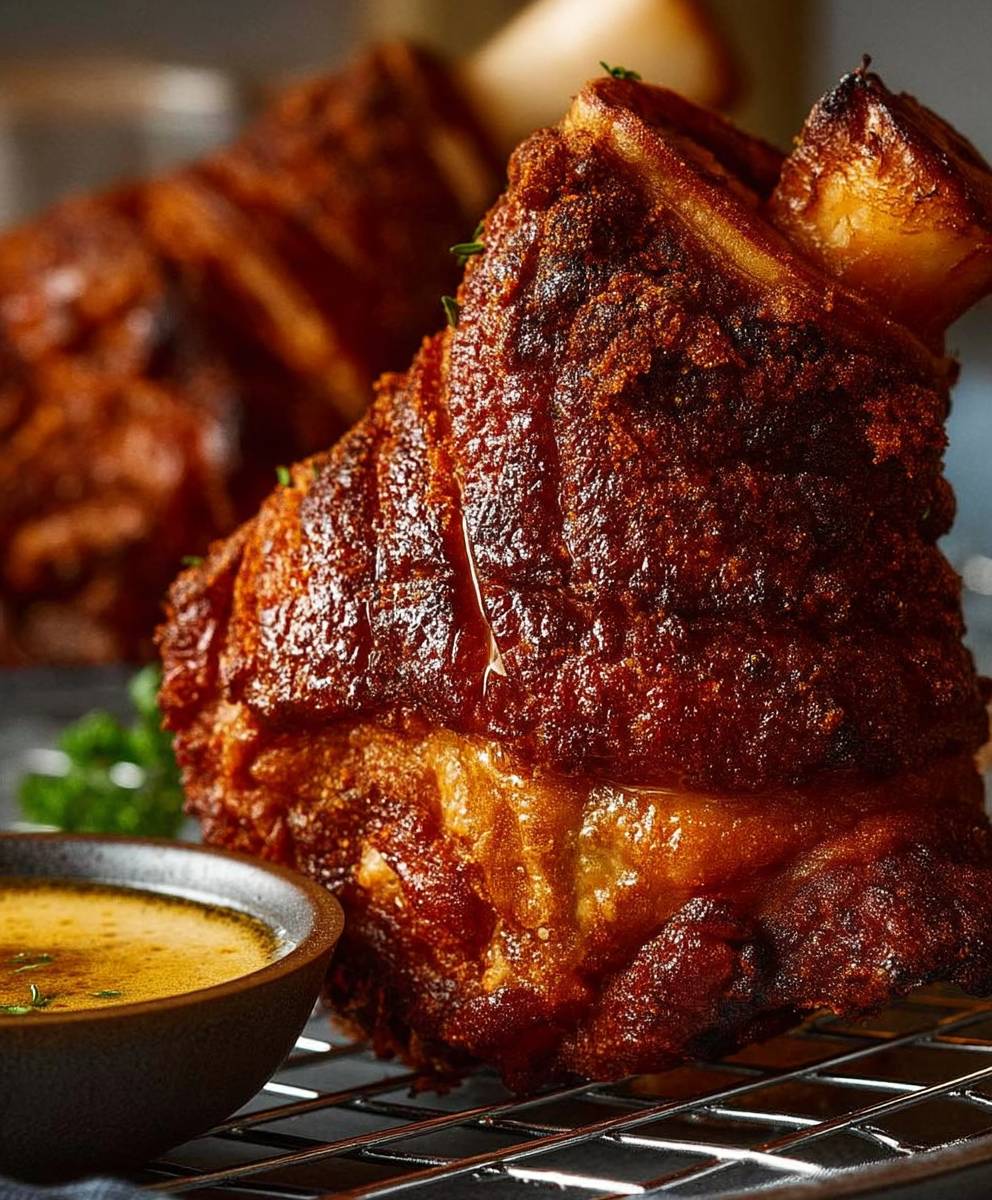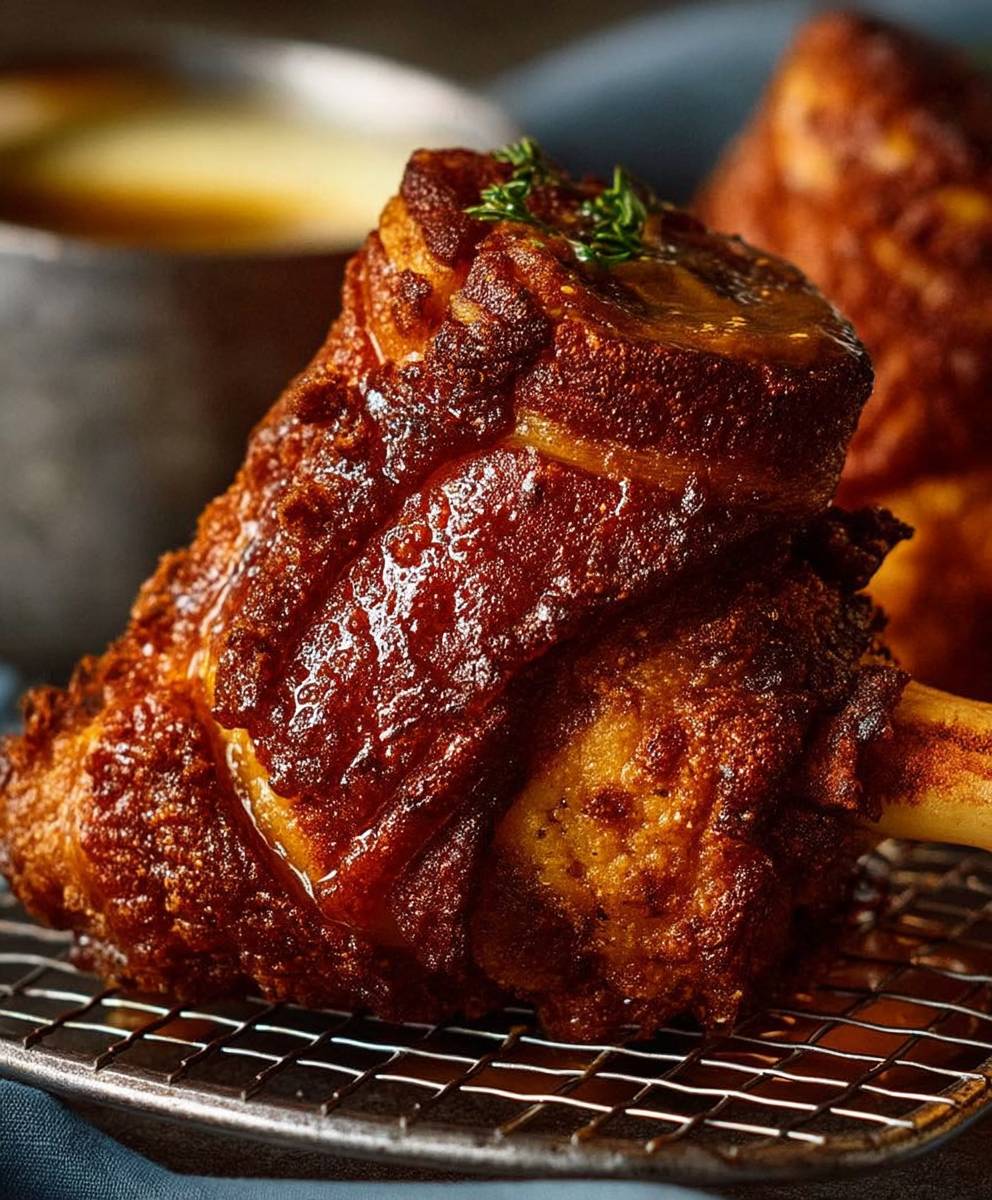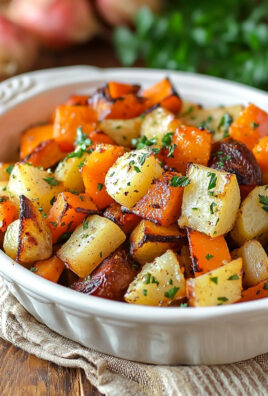German Pork Knuckle, also known as Schweinshaxe, is a dish that promises a symphony of textures and flavors, a true celebration of German culinary heritage. Imagine sinking your teeth into incredibly crispy, crackling skin that gives way to succulent, tender meat falling right off the bone. Is your mouth watering yet? Mine certainly is just thinking about it!
This iconic dish has deep roots in Bavarian cuisine, where it has been enjoyed for centuries. It was traditionally a hearty meal for farmers and laborers, providing the sustenance needed for a long day’s work. The preparation of German Pork Knuckle is a testament to resourcefulness, utilizing a cut of meat that, when cooked properly, transforms into something truly extraordinary.
What makes Schweinshaxe so beloved? It’s the perfect combination of textures the satisfying crunch of the skin contrasting with the melt-in-your-mouth tenderness of the pork. The rich, savory flavor is enhanced by traditional accompaniments like sauerkraut and potato dumplings, creating a complete and utterly satisfying meal. Plus, it’s a dish that’s perfect for sharing with friends and family, making it a centerpiece for festive gatherings and celebrations. So, let’s embark on a culinary adventure and learn how to create this masterpiece in your own kitchen!
Ingredients:
- 1 (4-5 pound) fresh pork knuckle (Schweinshaxe), skin on
- 2 tablespoons vegetable oil
- 1 large onion, roughly chopped
- 2 carrots, roughly chopped
- 2 celery stalks, roughly chopped
- 4 cloves garlic, crushed
- 1 tablespoon tomato paste
- 1 teaspoon caraway seeds
- 1 teaspoon marjoram
- 1/2 teaspoon dried thyme
- 1/2 teaspoon black peppercorns
- 2 bay leaves
- 1 bottle (12 ounces) dark beer (Dunkel or Bock recommended)
- 6 cups chicken or pork broth (or water)
- 1 tablespoon apple cider vinegar
- Salt, to taste
- Fresh parsley, chopped (for garnish)
Preparing the Pork Knuckle:
- Prepare the Skin: This is crucial for crispy skin! Pat the pork knuckle completely dry with paper towels. Using a very sharp knife or a box cutter (be extremely careful!), score the skin in a crosshatch pattern. Make sure to cut through the skin, but avoid cutting into the meat. The closer the scores, the crispier the skin will be. Aim for about 1/2 inch spacing.
- Season Generously: Rub the entire pork knuckle, including the scored skin, generously with salt. Don’t be shy! The salt will help draw out moisture and contribute to the crisping process. Let the salted pork knuckle sit uncovered in the refrigerator for at least 4 hours, or preferably overnight. This drying process is key to achieving that perfect crackling.
Braising the Pork Knuckle:
- Sear the Pork Knuckle: Heat the vegetable oil in a large, heavy-bottomed pot or Dutch oven over medium-high heat. Remove the pork knuckle from the refrigerator and pat it dry again with paper towels. Sear the pork knuckle on all sides until deeply browned. This step adds a lot of flavor to the braising liquid. Don’t overcrowd the pot; you may need to do this in batches. Remove the pork knuckle from the pot and set aside.
- Sauté the Vegetables: Add the chopped onion, carrots, and celery to the pot and cook over medium heat until softened and lightly browned, about 8-10 minutes. Stir occasionally to prevent burning.
- Add Aromatics: Add the crushed garlic and tomato paste to the pot and cook for another minute, stirring constantly, until fragrant.
- Deglaze the Pot: Pour in the dark beer and scrape up any browned bits from the bottom of the pot. This is where a lot of flavor is hiding! Let the beer simmer for a few minutes to reduce slightly.
- Add the Pork Knuckle and Broth: Return the pork knuckle to the pot. Add the caraway seeds, marjoram, thyme, peppercorns, and bay leaves. Pour in enough chicken or pork broth (or water) to almost completely cover the pork knuckle.
- Bring to a Simmer: Bring the liquid to a simmer, then reduce the heat to low, cover the pot, and braise for 3-4 hours, or until the pork is very tender and almost falling off the bone. Check the liquid level occasionally and add more broth or water if needed to keep the pork knuckle mostly submerged.
- Add Vinegar: During the last 30 minutes of braising, stir in the apple cider vinegar. This will add a touch of acidity that balances the richness of the pork.
Crisping the Skin:
- Preheat Oven: Preheat your oven to 450°F (232°C).
- Remove and Dry: Carefully remove the pork knuckle from the braising liquid and place it on a baking sheet lined with parchment paper or a wire rack. Pat the skin completely dry with paper towels. This is crucial for achieving crispy skin in the oven.
- Optional: Score Again: If you feel the skin needs more scoring, you can carefully score it again at this point.
- Roast to Crisp: Place the baking sheet in the preheated oven and roast for 20-30 minutes, or until the skin is puffed up and golden brown and crispy. Keep a close eye on it to prevent burning. If the skin is browning too quickly, you can lower the oven temperature slightly.
- Broil for Extra Crispness (Optional): For an extra crispy finish, you can broil the pork knuckle for a few minutes, watching it very carefully to prevent burning.
Serving:
- Rest: Let the pork knuckle rest for 10-15 minutes before carving. This allows the juices to redistribute, resulting in a more tender and flavorful meat.
- Carve and Serve: Carve the pork knuckle and serve immediately. The meat should be incredibly tender and juicy, and the skin should be wonderfully crispy.
- Serve with Accompaniments: Traditionally, German pork knuckle is served with sauerkraut, potato dumplings (Kartoffelknödel), or mashed potatoes. Mustard is also a must-have condiment.
- Enjoy the Braising Liquid: Don’t discard the braising liquid! Strain it and use it as a sauce or gravy for the pork knuckle and side dishes. You can also reduce it further for a more concentrated flavor.
- Garnish: Garnish with fresh chopped parsley for a pop of color and freshness.
Tips for the Best German Pork Knuckle:
- The Skin is Key: Achieving crispy skin is the most important part of this recipe. Don’t skip the scoring and drying steps!
- Salt Generously: Salting the pork knuckle well in advance helps to draw out moisture and create crispy skin.
- Don’t Overcrowd the Pot: When searing the pork knuckle, make sure not to overcrowd the pot. This will lower the temperature of the oil and prevent proper browning.
- Low and Slow Braising: Braising the pork knuckle at a low temperature for a long period of time ensures that it becomes incredibly tender and flavorful.
- Adjust Seasoning: Taste the braising liquid throughout the cooking process and adjust the seasoning as needed.
- Use a Meat Thermometer: While not strictly necessary, using a meat thermometer can help you ensure that the pork knuckle is cooked to the proper internal temperature (around 190-200°F or 88-93°C) for maximum tenderness.
- Don’t Be Afraid to Experiment: Feel free to experiment with different herbs and spices to customize the flavor of the braising liquid to your liking.
Variations:
- Smoked Pork Knuckle: For a smoky flavor, you can use a smoked pork knuckle instead of a fresh one. Adjust the braising time accordingly, as smoked pork knuckles may require less cooking time.
- Different Beer: While dark beer is traditionally used, you can experiment with other types of beer, such as wheat beer or even a lighter lager.
- Root Vegetables: Add other root vegetables to the braising liquid, such as parsnips or turnips.
- Spices: Add other spices to the braising liquid, such as juniper berries or allspice.
Storage:
- Leftovers: Leftover pork knuckle can be stored in the refrigerator for up to 3-4 days.
- Reheating: Reheat the pork knuckle in the oven or microwave until heated through. You can also crisp up the skin again in the oven or under the broiler.
- Freezing: Cooked pork knuckle can be frozen for up to 2-3 months. Wrap it tightly in plastic wrap and then in aluminum foil to prevent freezer burn. Thaw overnight in the refrigerator before reheating.

Conclusion:
This German Pork Knuckle recipe isn’t just another dish; it’s an experience, a journey to the heart of Bavarian cuisine, and a guaranteed showstopper for any gathering. I truly believe that once you’ve tasted the crispy, crackling skin giving way to the succulent, tender meat beneath, you’ll understand why this recipe is an absolute must-try. It’s more than just food; it’s a celebration of flavor and tradition.
Think about it: the deeply savory aroma filling your kitchen as it roasts, the satisfying crunch as you cut into the perfectly rendered skin, and the melt-in-your-mouth texture of the pork itself. This isn’t something you can easily replicate with a quick takeout order. This is a dish that demands to be savored, appreciated, and shared.
But the best part? It’s surprisingly achievable at home! While it requires some time and patience, the steps are straightforward, and the reward is immeasurable. I’ve broken down the process into manageable steps, ensuring that even novice cooks can achieve restaurant-quality results.
Now, let’s talk about serving suggestions and variations. Traditionally, German Pork Knuckle is served with sauerkraut and potato dumplings. The tangy sauerkraut cuts through the richness of the pork beautifully, while the dumplings provide a comforting and satisfying accompaniment. However, don’t feel limited by tradition!
Consider serving it with a creamy horseradish sauce for an extra kick, or alongside roasted root vegetables like carrots, parsnips, and potatoes for a heartier meal. For a lighter option, try pairing it with a fresh apple slaw or a simple green salad.
And if you’re feeling adventurous, why not experiment with different spice rubs? A blend of smoked paprika, garlic powder, and onion powder can add a smoky depth, while a touch of chili flakes can bring a welcome warmth. You could even try marinating the pork knuckle overnight in a mixture of beer, mustard, and herbs for an extra layer of flavor.
Leftovers (if you have any!) are fantastic in sandwiches, shredded into tacos, or added to stews and soups. The possibilities are endless!
I’m so excited for you to try this recipe and experience the magic of German Pork Knuckle for yourself. It’s a dish that’s sure to impress your family and friends, and it’s one that you’ll be proud to add to your culinary repertoire.
So, gather your ingredients, preheat your oven, and get ready to embark on a delicious adventure. And please, don’t be shy! I’d love to hear about your experience. Share your photos, your tips, and your variations in the comments below. Let’s create a community of German Pork Knuckle enthusiasts! I can’t wait to see what you create! Happy cooking!
German Pork Knuckle: A Crispy, Authentic Recipe
Crispy and tender German Pork Knuckle (Schweinshaxe) braised to perfection and roasted for ultimate crackling skin. A traditional Bavarian delight!
Ingredients
- 1 (4-5 pound) fresh pork knuckle (Schweinshaxe), skin on
- 2 tablespoons vegetable oil
- 1 large onion, roughly chopped
- 2 carrots, roughly chopped
- 2 celery stalks, roughly chopped
- 4 cloves garlic, crushed
- 1 tablespoon tomato paste
- 1 teaspoon caraway seeds
- 1 teaspoon marjoram
- 1/2 teaspoon dried thyme
- 1/2 teaspoon black peppercorns
- 2 bay leaves
- 1 bottle (12 ounces) dark beer (Dunkel or Bock recommended)
- 6 cups chicken or pork broth (or water)
- 1 tablespoon apple cider vinegar
- Salt, to taste
- Fresh parsley, chopped (for garnish)
Instructions
- Prepare the Skin: Pat the pork knuckle completely dry with paper towels. Using a very sharp knife or a box cutter (be extremely careful!), score the skin in a crosshatch pattern. Make sure to cut through the skin, but avoid cutting into the meat. The closer the scores, the crispier the skin will be. Aim for about 1/2 inch spacing.
- Season Generously: Rub the entire pork knuckle, including the scored skin, generously with salt. Don’t be shy! The salt will help draw out moisture and contribute to the crisping process. Let the salted pork knuckle sit uncovered in the refrigerator for at least 4 hours, or preferably overnight. This drying process is key to achieving that perfect crackling.
- Sear the Pork Knuckle: Heat the vegetable oil in a large, heavy-bottomed pot or Dutch oven over medium-high heat. Remove the pork knuckle from the refrigerator and pat it dry again with paper towels. Sear the pork knuckle on all sides until deeply browned. This step adds a lot of flavor to the braising liquid. Don’t overcrowd the pot; you may need to do this in batches. Remove the pork knuckle from the pot and set aside.
- Sauté the Vegetables: Add the chopped onion, carrots, and celery to the pot and cook over medium heat until softened and lightly browned, about 8-10 minutes. Stir occasionally to prevent burning.
- Add Aromatics: Add the crushed garlic and tomato paste to the pot and cook for another minute, stirring constantly, until fragrant.
- Deglaze the Pot: Pour in the dark beer and scrape up any browned bits from the bottom of the pot. This is where a lot of flavor is hiding! Let the beer simmer for a few minutes to reduce slightly.
- Add the Pork Knuckle and Broth: Return the pork knuckle to the pot. Add the caraway seeds, marjoram, thyme, peppercorns, and bay leaves. Pour in enough chicken or pork broth (or water) to almost completely cover the pork knuckle.
- Bring to a Simmer: Bring the liquid to a simmer, then reduce the heat to low, cover the pot, and braise for 3-4 hours, or until the pork is very tender and almost falling off the bone. Check the liquid level occasionally and add more broth or water if needed to keep the pork knuckle mostly submerged.
- Add Vinegar: During the last 30 minutes of braising, stir in the apple cider vinegar. This will add a touch of acidity that balances the richness of the pork.
- Preheat Oven: Preheat your oven to 450°F (232°C).
- Remove and Dry: Carefully remove the pork knuckle from the braising liquid and place it on a baking sheet lined with parchment paper or a wire rack. Pat the skin completely dry with paper towels. This is crucial for achieving crispy skin in the oven.
- Optional: Score Again: If you feel the skin needs more scoring, you can carefully score it again at this point.
- Roast to Crisp: Place the baking sheet in the preheated oven and roast for 20-30 minutes, or until the skin is puffed up and golden brown and crispy. Keep a close eye on it to prevent burning. If the skin is browning too quickly, you can lower the oven temperature slightly.
- Broil for Extra Crispness (Optional): For an extra crispy finish, you can broil the pork knuckle for a few minutes, watching it very carefully to prevent burning.
- Rest: Let the pork knuckle rest for 10-15 minutes before carving. This allows the juices to redistribute, resulting in a more tender and flavorful meat.
- Carve and Serve: Carve the pork knuckle and serve immediately. The meat should be incredibly tender and juicy, and the skin should be wonderfully crispy.
- Serve with Accompaniments: Traditionally, German pork knuckle is served with sauerkraut, potato dumplings (Kartoffelknödel), or mashed potatoes. Mustard is also a must-have condiment.
- Enjoy the Braising Liquid: Don’t discard the braising liquid! Strain it and use it as a sauce or gravy for the pork knuckle and side dishes. You can also reduce it further for a more concentrated flavor.
- Garnish: Garnish with fresh chopped parsley for a pop of color and freshness.
Notes
- Achieving crispy skin is the most important part of this recipe. Don’t skip the scoring and drying steps!
- Salting the pork knuckle well in advance helps to draw out moisture and create crispy skin.
- Don’t overcrowd the pot when searing the pork knuckle. This will lower the temperature of the oil and prevent proper browning.
- Braising the pork knuckle at a low temperature for a long period of time ensures that it becomes incredibly tender and flavorful.
- Taste the braising liquid throughout the cooking process and adjust the seasoning as needed.
- Use a meat thermometer to ensure that the pork knuckle is cooked to the proper internal temperature (around 190-200°F or 88-93°C) for maximum tenderness.
- Feel free to experiment with different herbs and spices to customize the flavor of the braising liquid to your liking.
- For a smoky flavor, you can use a smoked pork knuckle instead of a fresh one. Adjust the braising time accordingly, as smoked pork knuckles may require less cooking time.
- While dark beer is traditionally used, you can experiment with other types of beer, such as wheat beer or even a lighter lager.
- Add other root vegetables to the braising liquid, such as parsnips or turnips.
- Add other spices to the braising liquid, such as juniper berries or allspice.
- Leftover pork knuckle can be stored in the refrigerator for up to 3-4 days.
- Reheat the pork knuckle in the oven or microwave until heated through. You can also crisp up the skin again in the oven or under the broiler.
- Cooked pork knuckle can be frozen for up to 2-3 months. Wrap it tightly in plastic wrap and then in aluminum foil to prevent freezer burn. Thaw overnight in the refrigerator before reheating.





Leave a Comment